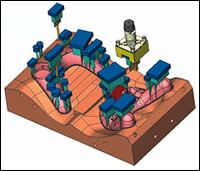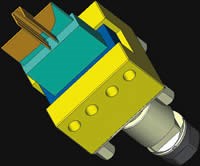The Key to Better Electrode Making
Smooth out the process, eliminate unnecessary steps, reduce errors and automate repeat work by using a single software solution throughout electrode design and manufacture.
Creating and using EDM (electro discharge manufacturing) electrodes is considered a painful challenge by most moldmakers because it is time consuming, slows down mold production and requires precision. Given the option, most toolmakers would rather mill the steel and avoid electrodes altogether. Nevertheless, electrodes are still required for a good portion of moldmaking jobs with some molds requiring many electrodes. Parts with narrow ribs and sharp internal corners are good examples for such cases. As a result, moldmakers are constantly searching for processes and technologies to ease the pain of creating electrodes. Dedicated electrode design and manufacturing software is one such solution. Following are some strategies a moldmaker can use to make the most out of using electrode design and manufacturing software.
Get an Early Start
In traditional moldmaking practices, electrode design is typically the last step in the mold design process. Using concurrent engineering, electrode design can be performed in parallel to the splitting of core and cavity. Multiple users can work concurrently on the same project, thereby expediting the mold design process.
Use Guidance
With the many steps involved in the electrode design process, even the most experienced users can use some help and guidance, and novice users can get up to speed quicker if taken through the process step-by-step.
A software wizard can do just that, assisting a user in the many steps involved: selecting the electrode area, extracting the electrode surfaces, developing extension surfaces, selecting a blank, base and holder, creating a boundary, determining burn locations and creating inspection drawings.
Automate Processes
Wouldn’t it be nice if software could also avoid some of the tedious and time-consuming details involved in the electrode design? This is exactly what some of the advanced electrode software packages can do. Automation not only helps a toolmaker get the electrode done quicker, but also ensures greater levels of accuracy and consistency, and with fewer errors.
For example, the software should be able to find a base and automatically extend the electrode to interface with the holder. Automatic extraction of the electrode surfaces is another function that can greatly benefit users. The software should also dynamically position and rotate blanks to determine burn areas and then automatically fit each blank to the selected burn area.
To save time and resources in creating accurate documentation, the electrode software should automate the tedious task of drafting and documenting the electrode process.
Reuse Knowledge
Although each mold and electrode could be different, there is a great deal of repetition that can be avoided by saving common tasks and processes as templates for future use. For example, the process described above for extending the surfaces can be saved as a template—with different templates for different electrode contours. Templates also can be used to generate assembly, inspection and burning location drawings.
Use a Single Solution for Design and Manufacturing
Using a single software solution throughout the electrode design and manufacturing process—electrode creation and drawing, customizable electrode reports, seamless integration to NC and automatic programming for an EDM—can go a long way to smooth out the process and eliminate unnecessary steps, data transfers and reduce the probability of errors and repeat work.
Integrated design and manufacturing electrode software should automate the electrode production process while providing complete control over all machining and burning parameters. In order to maintain flexibility, the system should allow the definition of both general and machine-specific parameters, electrodes and burning locations.
To ensure the information is communicated accurately to the shop floor, the software should provide setup sheets, including detailed instructions as required by the machine operators. The best solutions will provide direct interface of the setup data to the EDM, avoiding operator errors and greatly speeding up the setup process. Support for high-speed milling is a must for most tool shops these days. To ensure a streamlined production process, the software should automatically generate the most efficient toolpaths, using continuously updated knowledge of actual remaining stock.
Get User Buy-In
No matter what level of functionality the software offers, it has little value unless properly used. Some users may be reluctant to use automatic functions and templates, fearing they might lose control over the process and its results. Tool shop executives can address such user concerns on three levels:
1. Technology
The software must allow users to do things their way even if there is a better and quicker way for accomplishing the task. Users always must have the ability to override system defaults, modify templates and manually execute specific tasks.2. Training
Too often a software package is thrown at the users without proper training. Always pressed for time, users may feel that self-training is an acceptable shortcut. This however, typically ends up causing users to spend valuable time trying to figure things out on their own, lengthening the learning curve beyond what is necessary. Moreover, lacking proper training, users may never use the full potential of the software, sacrificing long-term productivity for short-lived budget and time savings.3. Support
Without proper support, users may end up struggling with software issues instead of getting their jobs done. To avoid such productivity loss, tool shop managers need to consider the vendor’s support capability when evaluating an electrode software package.
The Bottom Line
With the proper processes, people and technology in place, what used to be a painful task can become much more efficient, manageable, and better integrated into the entire tool design and creation process.
Related Content
Adopting AI: A Pragmatic Approach to Your AI Journey
How mold builders can start AI efforts without expensive system overhauls or major changes.
Read MoreMMT Chats: Injection Molds and Integrated Solutions Through Ambition and Innovation
Jordan Robertson, VP, Business Development and Marketing for StackTeck discusses various mold technologies to improve efficiencies in automation, cooling, lightweighting and sustainability.
Read More2024 Moldmaking Insights: A Year in Review Part 1
A look back at the top moldmaking trends of 2024, as revealed through MMT's analytics. This review highlights the most popular technical articles, case studies, tips and best practices that captured the industry's attention over the past year.
Read MoreHow to Automate Process and Design in Moldmaking
Mold builders can achieve major operational improvements by automating their digital workflows, particularly in CAD/CAM design, programming and process planning.
Read MoreRead Next
How to Implement Ultra Productive EDM
Steps to help maximize the potential of your current die sink or wire EDM system.
Read MoreHow to Use Strategic Planning Tools, Data to Manage the Human Side of Business
Q&A with Marion Wells, MMT EAB member and founder of Human Asset Management.
Read MoreReasons to Use Fiber Lasers for Mold Cleaning
Fiber lasers offer a simplicity, speed, control and portability, minimizing mold cleaning risks.
Read More























